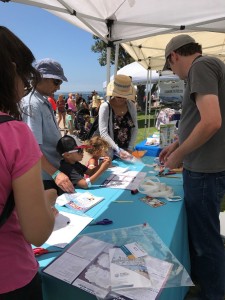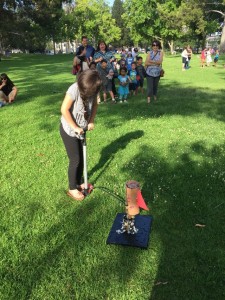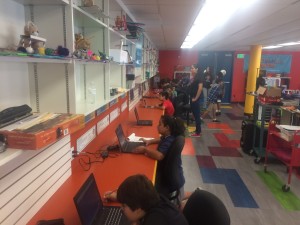Guest blog by David Janning and Joanna Ritchie (Chula Vista Library, a NASA@ My Library Partner)
Many events you host already include the concept of layering, which typically involves setting up multiple activity stations and staggering main events throughout the length of a program. Layering also enables you to share information and experiences in multiple formats, such as showing a short video at the start of your activity to delve deeper into the content. When hosting an event at your library, it’s best to keep the concept of layering in the back of your mind. Below you’ll discover how layering contributes to the success of your program and examples of what to do.
Why Layer?
Carnivals and fairs are great illustrations of what layering looks like: having multiple stations that vary in difficulty or interest to target specific attendees. Library programs can use the same principles when layering their activities. Layering is important because it helps prevent bottle-necking and allows patrons to move around to less populated tables or to visit booths of special interest, maximizing space needs.
Libraries can stagger activity start times to account for the waves of people coming and going. For example, if someone missed an activity’s start time, they can come back when it begins again. In this way, more complicated activities can be broken down into smaller components that are easier to manage, allowing station leads to stay on task without needlessly starting a demonstration over again.
Layering also creates opportunities for volunteers and staff to manage a smaller portion of the program more independently. The organizer can then float through the space to keep the schedule on track, ensure safety, and spend time building community connections and obtaining feedback from attendees.
How to Layer?
Consider your expected audience. Will you have families? Is it kids only? Will adults participate? Know who you’re targeting and base activities around the different groups. Layered programs make program prep easier, especially if you create a routine. At our library, for instance, we follow a standardized in format. This helps reduce confusion and improves the flow of the program. The bottle rocket sample guide provided is an example of the format we use for most programs.
Hosting a space-themed program for younger kids might include a station for examining crater impacts, a computer for exploring exoplanets, and building a rover landing device with LEGOs and miscellaneous supplies – think along the lines of an egg-drop challenge, but using LEGOs instead of messy eggs (example). Since the LEGO Rover Challenge takes longer to complete, you can incorporate a short video clip discussing exploration on Mars during the introduction. This is layering on a smaller scale.
What about your tweens and teens? The exoplanet activity mentioned above is a good example of a scalable activity. While younger kids can have fun exploring different planets and testing the features of the website, older kids can go into more depth with the site. If your library has a green screen, have the older kids create a short digital report on the facts they garnered from the exoplanets website. These can be shared via social media to create community dialogue about STEM programs.
Logistics
Layered programs can range from a small community program to large fair-style events. Design programs with your community space and needs in mind. If space is a limiting factor, you may have to get creative with your space usage, but be realistic with your attendance size. Although, rarely is a crowded library a bad thing! Also, keep in mind the number of assistants you’ll need. Too many volunteers become cumbersome to manage, while too few can leave your staff overburdened, thus defeating the purpose of layering as a management strategy. Plan your events far in advance to allow adequate time for training volunteers and having them set up supplies.
Reliable and enthusiastic volunteers are key to a successful layered program. They must be comfortable working alone, capable of troubleshooting and enthusiastic. Whenever possible it is always recommended to partner with subject experts. Local robotics or astronomy clubs, for example, can bring expertise and excitement to a program. Tap into their network of peers for potential volunteers and offer them the option of setting up a table to promote their group or service. These partnerships can connect you to experts and resources you might not have access to otherwise.
Provide training for all staff and volunteers involved, include a schedule, each stations duties, points of contact and a map similar to the example provided earlier. Trained assistants allow your program lead a chance to float, assisting where needed, directing patrons and networking with the community.
Wrapping it up
Layering programs enables you to develop exciting and engaging programs that more effectively share information. These programs run smoother, with volunteers and staff empowered to independently run a station, freeing the program lead to focus on safety, troubleshooting and community engagement. Being able to get positive feedback through surveys and social media helps to reinforce a positive image of the library in the community and find new partnerships. Engaging your patrons tends to get overlooked if an event is hectic and one person is handling multiple tasks. Good luck using layering to your advantage to make the most out of your budget and time.
For further questions, please contact David Janning: djanning@chulavista.lib.ca.us or Joanna Ritchie: jritchie@chulavista.lib.ca.us
Find more tips about layering your programs from the 2017 Internet Librarian Conference presentation, NASA@ My Library, by Keliann LaConte (STAR Net/National Center for Interactive Learning, Space Science Institute); David Janning and Joanna Ritchie (Chula Vista Public Library); and Kevin Tolley (Solano County Library) at http://internet-librarian.infotoday.com/2017/Presentations.aspx.







Leave A Comment